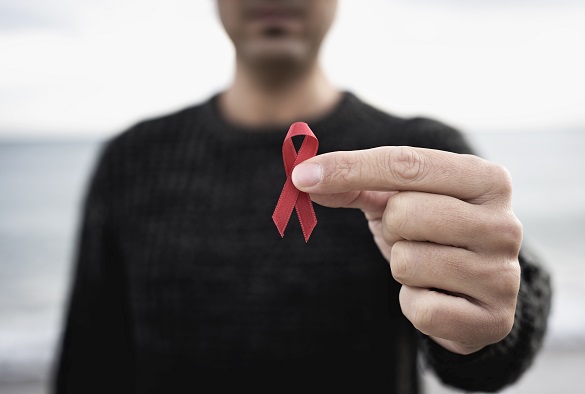It wasn't just an inconvenience. It was a medical necessity.
Robert Schmitt was forced to leave his friends and head back to his San Francisco home early and alone one New Year's Eve, all because he had forgotten to bring his pill.
Schmitt needed to take his medication every single night at exactly 11 p.m. Diagnosed with HIV in 1995, missing a dose could make it easier for the virus to change form, causing the medication to stop working.
“I lived my life by a series of alarms and timers,” Schmitt said.
That all changed for the 68-year-old Diamond Heights resident last year. He was able to put the pills behind him thanks to a new treatment: bimonthly injections.
“It was like a burden had been lifted,” Schmitt said.
Schmitt is a participant in an ongoing study at Ward 86, Zuckerberg San Francisco General Hospital’s renowned HIV clinic, that could radicalize treatment for people who struggle the most with the disease. The program could pave the way to expanding access to a cutting-edge HIV treatment for patients nationwide, though for now, it’s pushing the limit past how mainstream officials instruct physicians to use it.

A New Evolution in HIV Treatment
Dr. Monica Gandhi, the clinic’s 54-year-old medical director, says that when she first arrived in San Francisco as a medical intern in 1996, the city was the epicenter of the pandemic in the U.S. That year, a fundamentally life-altering new highly active antiretroviral treatment came out.
“I literally saw the first half of my year, people, sadly, dying. And then I saw people almost rise from the dead by the second half of the year,” Gandhi said. “It was that transformational.”
Then, she spent more than a decade helping her patients manage through the significant side effects the drugs caused. But over time, the medications got better and better. Eventually, researchers developed a daily pill regimen that is so effective that, when taken properly, it can reduce the amount of virus a person has in their body—their viral load—down to an undetectable level that cannot be sexually transmitted, even during unprotected sex.
“And it should be really easy,” said Gandhi, who has led Ward 86 since 2014. “HIV, in a way, should not even be a problem any more.”
But there’s a crucial downside to daily pills.
Many people living with HIV suffer from homelessness, chronic mental illness, substance use disorder or a combination of all three.
And the instability that comes along with those circumstances can make it hard to take pills every day.
A seismic shift in HIV treatment arrived two years ago when the U.S. Food and Drug Administration approved new long-acting injection therapies for the disease. Instead of daily pills, people living with HIV could now receive a bimonthly shot. But there was a caveat: The regimen was approved only for patients who already took pills and had successfully suppressed their viral load.
Gandhi, despite the FDA instructions, recognized the huge potential to help people who struggled to keep up with their pill regimens. In a few month’s time, Ward 86 began giving the long-acting injections to 133 people living with HIV in San Francisco, a little less than half of whom had not suppressed their viral load before beginning the treatment.
“I had a lot of clinicians from around the country tell me, ‘Are you crazy? This is not what the FDA says you’re supposed to do,'” Gandhi said. “But our idea was that this is the patient population that needs these therapies the most. So we are going to start it on anyone who says they want it, even if their viral load is up.”
Promising Results
In the first year and a half of the program, Gandhi and her team found that nearly every participant, with the exception of two, achieved virologic suppression, or remained suppressed. More than half of the patients reported having unstable housing, with 8% experiencing homelessness. About a third are living with mental illness or reported substance abuse.
Gandhi presented the initial results in late February at the Conference on Retroviruses and Opportunistic Infections in Seattle.
“Dr. Gandhi and her team have made state-of-the-art HIV treatment finally available to people with unique challenges, like those who use drugs, and have found success,” said Dr. Nora Volkow, director of the National Institute on Drug Abuse, in a statement. “This is the sweet spot for addressing HIV―thinking outside the box to deliver care in a way that meets people’s needs.”
Now, Gandhi plans to participate in a larger study covering cities beyond San Francisco to collect more data about the treatment’s potential for people with unsuppressed viral loads.
Over the past decade, people experiencing homelessness have made up a larger and larger share of new HIV diagnoses in San Francisco, reaching nearly 25% in 2021, according to the Department of Public Health. Only about a quarter of homeless people living in San Francisco with HIV are virologically suppressed, a far lower rate than the overall population of people living with the disease, Gandhi said.
Schmitt, the study participant, said he hasn’t experienced homelessness, but found keeping up with the daily pills hard enough. He can only imagine how much more challenging it must be for people struggling to find their next meal, or find a place to sleep for the night.
The retiree is thrilled the new injection treatment means less time waiting in line at the pharmacy and more time for his passions, like swimming and listening to classical music.
“I never thought I’d live to see the day where I could get an HIV medicine once every eight weeks,” Schmitt said. “I thought I was going to be with pills for the rest of my life every day.”
